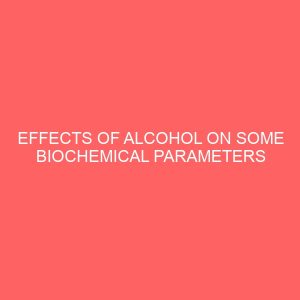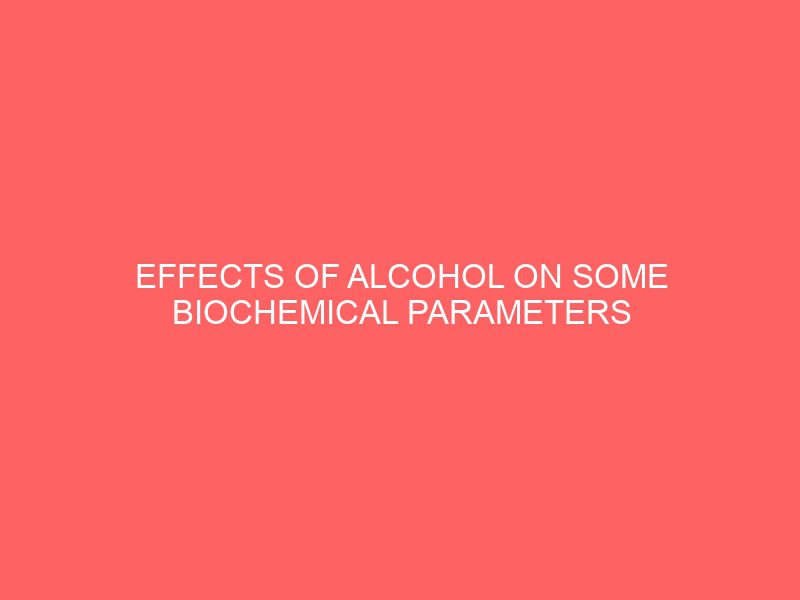Description
CHAPTER ONE
INTRODUCTION
This research is on Effects of alcohol on some biochemical parameters of alcoholics in Nsukka, Enugu state, Nigeria. Generally, alcohol designates a class of compounds that are hydroxyl derivatives of aliphatic hydrocarbons. However, in this study, the term alcohol used without additional qualifications refers specifically to ethanol. A variety of alcoholic beverages have been consumed by man in the continuing search for euphoria producing stimuli. Among some people, alcohol enjoys a high status as a social lubricant that relieves tension, gives self confidence to the inadequate, blurs the appreciation of uncomfortable realities and serves as an escape from environmental and emotional stress.
Alcohol has been loved and hated at different times by different people. Alcohol has been celebrated as healthful especially to the heart (red wine) and most pleasant to the taste buds; and then dismissed as “demon’s rum” and “devil in solution” depending on the prevalent view.
In spite of the apparent divergent and sometimes conflicting opinions about alcohol, the consensus shared by drinkers and non drinkers alike is that excessive and chronic consumption of alcohol is a disorder. Like any other chronic disorder, it develops insidiously but follows a predictable course. The first or pre-alcoholic symptomatic phase begins with the use of alcohol to relieve tensions. The second (or prodromal) phase is marked by a range of behaviours including preoccupation with alcohol, surreptitious drinking and loss of memory (Hock et al., 1992). In the third (or crucial) phase, the individual loses control over his drinking. This loss of control is the beginning of the disease process of addiction. The individual starts drinking early in the morning and stays up drinking till late in the night. Impairment in biochemical activities becomes manifest as the organs of the alcoholic begin to deteriorate. Other medical problems develop by the time the alcoholic gets into the final (chronic phase). Prolonged intoxications become the rule. Alcoholic psychosis develops, thinking is impaired, and fear and tremors become persistent (Klemin and Sherry, 1981). A previously responsible individual may be transformed into an inebriate – s tereotype alcoholic.
Fear-instilling but thought- provoking terms such as the “coming epidemic”, a “miserable trap”, have b een used to show concern for the potential hazard of widespread alcoholism.
In its 1978 revision of the international classification of diseases, the World Health Organization defined alcoholism as “a state, psychic and usually also physical, resulting from taking alcohol, characterized by behavioral and other responses that always include a compulsion to take alcohol on a continuous or periodic basis in order to experience its psychic effects and sometimes to avoid the discomfort of its absence; tolerance may or may not be present. This definition emphasized the compulsive nature of drinking, the psychological and physical effects, and dependence (“discomfort of its absence”) (WHO, 1978).
The kidney and liver could be particularly vulnerable to the chemical assault resulting from alcohol abuse because they receive high percentage of the total cardiac output. Also, the liver is pivotal in intermediary metabolism; so ingested alcohol must come in contact with the liver and kidney. Alcohol could produce many of its damaging effects by the formation of dangerous, highly reactive intermediates such as acetaldehyde which may lead to glutathione depletion, free radical generation, oxidative stress and cell dysfunction.
Alcohol dehydrogenase in the presence of a hydrogen acceptor nicotinamide adenine dinucleotide (NAD) oxidizes ethanol to acetaldehyde. This is the initial obligatory biochemical event in alcohol induced hepatotoxic and nephrotoxic effects. Thus, it is important to find out in quantitative terms the effects of different types of alcohol drinks on some principal biochemical parameters of diagnostic utility.
- Alcohol
1.1.1 Chemistry of Alcohol
The term ‘alcohol’ refers to a class of compounds t hat are hydroxy (-OH) derivatives of aliphatic hydrocarbons. There are many common alcohols – methanol or wood alcohol, isopropyl alcohol, the antifreeze diethylene glycol, and glycerine. In this study however, when the term alcohol is used without additional qualification, ethyl alcohol, a liquid also known as ethanol, is referred to. Alcohol can be considered as being derived from the corresponding alkanes by replacing the hydrogen atoms with hydroxyl groups. The hydroxyl group is the functional group of alcohols as it is responsible for their characteristic chemical properties. Monohydric alcohols contain only one hydroxyl group in each molecule. Monohydric alcohols form a homologues series with the general molecular formular CnH2n+1OH.
All alcoholic beverages arise from the process of fermentation. Indeed, ethanol, the alcohol in beverages, is the quantitative end product of yeast glycolysis. In the presence of water, yeasts are able to convert the sugar (glucose) of plants into alcohol, as depicted by the following chemical reaction:
A wide variety of plants have proved to be useful substrates for the action of yeast, and this is reflected by the different types of beverages used throughout the world.
1.1.2 Alcohol Production
- Beer Production
Beer is generally considered to be of two types, the ale types, brewed with Saccharomyces cerevisiae and the lager type, brewed with Saccharomyces carlsbergensis. The main ingredients of beer are malted barley, the source of fermentable carbohydrates, proteins, polypeptides, minerals, and hops the primary purpose of which is to impart bitterness and the hop characteristic, but which also have anti-microbial properties, yeast and water. The basic processes for the brewing of beer include:
- Malting
Malting involves the mobilization and development of the enzymes formed during germination of the barley grain. The grain is permitted to germinate under controlled conditions of moisture and temperature, the starch/enzyme balance then being fixed by kilning at drying temperatures as high as 104oC
(b) Mashing
During mashing, ground malt is mixed (mashed) with hot water. This serves both to extract existing soluble compounds from the malt and to reactivate malt enzymes which complete the breakdown of starch and proteins.
(c) Wort boiling
Wort is drained from the mash tun into a copper and boiled to inactivate malt enzymes. In traditional brewing, hops are added at this stage, the humulones (α-acids) being extracted and chemically isomerized. The resulting iso-humulones have a greater solubility and contribute the characteristic bitter flavour to beer, while the ‘hop character’ i s derived from essential oils. In recent years, there has been a tendency to replace hop cones with various types of hop pellets, powders or extracts including pre-isomerized hop products which may be added after fermentation. Boiling serves two other functions: reducing the potential for microbiological problems by effectively sterilizing the wort and coagulation of proteins followed by their removal as ‘trub’. Inadequate coagulation may adversely affect the subsequent fermentation due to interference with yeast: substrate exchange processes (membrane blocking) and lead to poor quality beer.
(d) Fermentation
Fermentations are considered to be of two distinct types: the top fermentation used in production of ales, in which CO2 carries flocculated Sacch. cerevisiae to the surface of the fermenting vessel, and the bottom fermentation used in production of lagers, in which Sacch. carlsbergensis sediments to the bottom of the vessel. Differentiation on the basis of the behaviour of the yeast is, however, becoming less distinct with the increasing use of cylindro-conical fermenters and centrifuges.
- Maturation (Conditioning; Secondary fermentation)
Maturation may be considered to include all transformations between the end of primary fermentation and the final filtration of the beer. These
include carbonation by fermentation of residual sugars, removal of excess yeast, adsorption of various non-volatiles onto the surface of the yeast and progressive change in aroma and flavour. During maturation, priming sugar may be added or amyloglucosidase used to hydrolyse dextrins.
- The Production of Palm Wine
There are two main sources of palmwine namely: raphia palm particularly Raphia vinifera and Raphia hookeri; and the oil palm: Elaeis guineensis. Palmwine is an alcoholic beverage produced from the fermenting palm sap. The part tapped is the male inflorescence of a standing oil palm tree. The fermentable sugars present in palm wine are glucose, sucrose, fructose, maltose, and raffinose. The yeast species – Saccharomyces spp are responsible mainly for the conversion of the sugars in palm sap into alcohol as well as oxidative fermentation of alcohol to acetic acid.
In the fermentation of natural palm wine, lactic acid bacteria, Lactobacillus plantarium, Leuconostoc mentseriodes and Pediococcus cerevisiae are also involved. All of them utilize meyerhof parnas pathway which results in the formation of alcohol as well as organic acids. The leuconostoc mesenteriode is a hetero-fermenter and ferments sugar to produce acetic acid., lactic acid, ethanol and carbondioxide. Lactobacillus plantarium is a homofermenter and ferments sugars to produce mainly lactic acid and small amount of alcohol and carbondioxide. Pediococcus cerevisiae is also a homo fermenter and produces the same metabolites as Lactobacillus plantarium. Thus, the bacterial flora of palm wine contribute significantly to the fermentation of sugars to alcohol and the alcoholic constituent of palm wine varies with the species of palm tree from which the wine was tapped.







